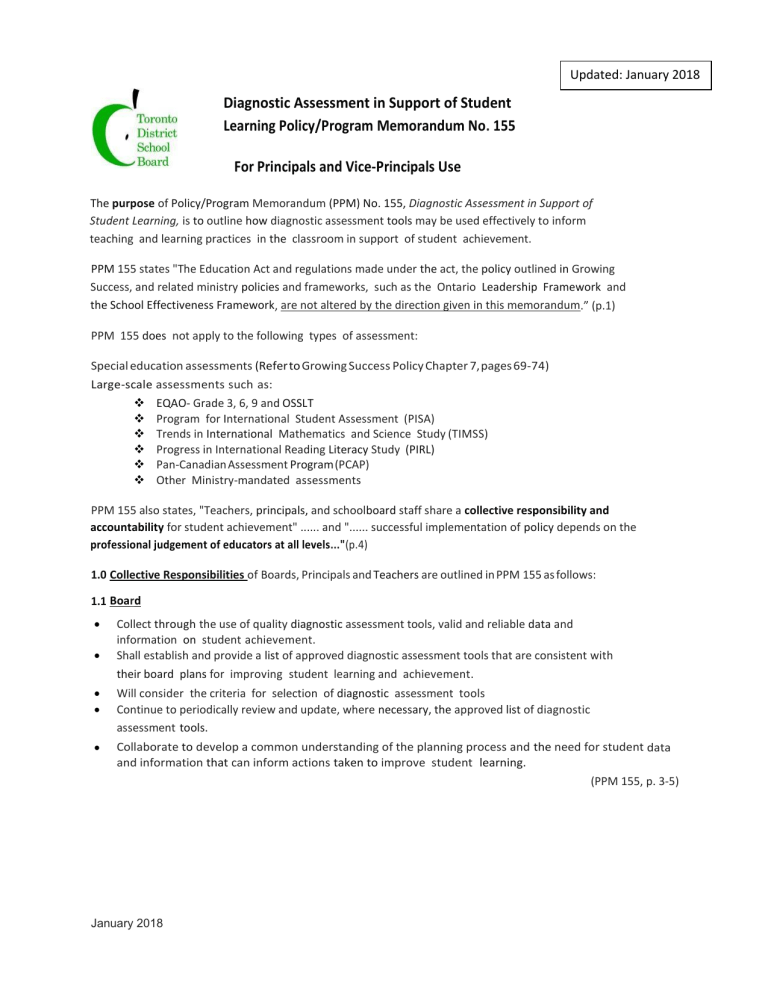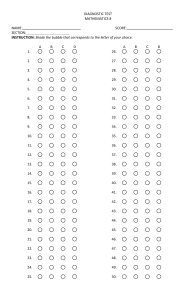
Updated: January 2018 Diagnostic Assessment in Support of Student Learning Policy/Program Memorandum No. 155 For Principals and Vice-Principals Use The purpose of Policy/Program Memorandum (PPM) No. 155, Diagnostic Assessment in Support of Student Learning, is to outline how diagnostic assessment tools may be used effectively to inform teaching and learning practices in the classroom in support of student achievement. PPM 155 states "The Education Act and regulations made under the act, the policy outlined in Growing Success, and related ministry policies and frameworks, such as the Ontario Leadership Framework and the School Effectiveness Framework, are not altered by the direction given in this memorandum.” (p.1) PPM 155 does not apply to the following types of assessment: Special education assessments (Refer to Growing Success Policy Chapter 7, pages 69-74) Large-scale assessments such as: ❖ ❖ ❖ ❖ ❖ ❖ EQAO- Grade 3, 6, 9 and OSSLT Program for International Student Assessment (PISA) Trends in International Mathematics and Science Study (TIMSS) Progress in International Reading Literacy Study (PIRL) Pan-Canadian Assessment Program (PCAP) Other Ministry-mandated assessments PPM 155 also states, "Teachers, principals, and schoolboard staff share a collective responsibility and accountability for student achievement" ...... and "...... successful implementation of policy depends on the professional judgement of educators at all levels..."(p.4) 1.0 Collective Responsibilities of Boards, Principals and Teachers are outlined in PPM 155 as follows: 1.1 Board • • Collect through the use of quality diagnostic assessment tools, valid and reliable data and information on student achievement. Shall establish and provide a list of approved diagnostic assessment tools that are consistent with their board plans for improving student learning and achievement. • • Will consider the criteria for selection of diagnostic assessment tools Continue to periodically review and update, where necessary, the approved list of diagnostic assessment tools. • Collaborate to develop a common understanding of the planning process and the need for student data and information that can inform actions taken to improve student learning. (PPM 155, p. 3-5) January 2018 1.2 Principals • • Ensure a consistent and continuous school-wide focus on student learning. Will provide leadership when working in collaboration with teachers to gather information about students’ learning in support of school and board improvement plans for student achievement. (PPM 155, p.5) 1.3 Teachers • • • Will use their professional judgement, as defined in Growing Success, when selecting and using diagnostic assessment tools. Must utilize diagnostic assessment during the school year, selecting tools from the board’s approved list. In selecting and using diagnostic assessment tools from the board’s list, teachers shall determine the following: ❖ The diagnostic assessment tools which are applicable; ❖ Which student(s) will be assessed (individual student, small group, or whole class); ❖ The frequency of use of the diagnostic assessment tools; ❖ The appropriate timing of the use of the diagnostic assessment tools. (PPM 155, p.5) 2.0 Professional Judgement Growing Success, page 152 defines professional judgment as follows: “Judgement that is informed by professional knowledge of curriculum expectations, context, evidence of learning, methods of instruction and assessment, and the criteria and standards that indicate success in student learning. In professional practice, judgement involves a purposeful and systematic thinking process that evolves in terms of accuracy and insight with ongoing reflection and self-correction.” 3.0 Diagnostic Assessment In Growing Success, the term diagnostic assessment is defined as “assessment that is used to identify a student’s needs and abilities and the student’s readiness to acquire the knowledge and skills outlined in the curriculum expectations. Diagnostic assessment usually takes place at the start of a school year, term, semester, or teaching unit. It is a key tool used by teachers in planning instruction and setting appropriate learning goals” (p. 146). Diagnostic assessment provides information that is “used by teachers and students to determine what students already know and can do with respect to the knowledge and skills identified in the overall and specific expectations” (p. 31 Growing Success). A list of TDSB Approved Diagnostic Assessment Tools in support of student learning that are consistent with TDSB board plans for improving student learning and achievement is attached. January 2018 TDSB Approved List of Diagnostic Assessment Tools Assessment/Tool Grades/Division Purpose Recommended Timelines Observation Survey Early Years Provides a comprehensive overview of a student’s level of literacy development; measures students’ skills and understanding of reading and writing On-going Running Records and Reading Conference K-12 Document students’ reading behaviours to determine a student’s instructional reading level; to create dynamic guided reading groups; to allow for documentation of progress over time On-going for all students; more frequently for those students who are experiencing difficulty with text DRA Primary K – 3 Junior 4 – 6 Intermediate 7 – 8 Provides information about individual student’s skills in reading (decoding, fluency and comprehension); assists in making instructional decisions when grouping students for modelled, shared, guided and independent reading Senior kindergarten: Spring – only for those students demonstrating an understanding of the concepts of print Grades 1 – 8: minimally twice a year, especially for students who are at level 2 and below in reading and writing CASI Junior 4 – 6 Intermediate 7 – 8 Assists teachers in determining students’ strengths and learning needs individually, as small groups or whole class profile; provides information on students’ attitudes to reading, reading preferences and interests; assists in making instructional decisions when grouping students for modelled, shared, guided and independent reading Grades 4 – 8: Fall and Spring Reading assessment may be administered in the middle of the year with students who require closer monitoring in reading Benchmark Assessment System K-2 (System 1) Provides materials and procedures for observing and assessing the reading levels and behaviours of students and it is directly linked to Fountas and Pinnell Levels A-Z. This assessment helps to identify each student’s independent, instructional, and hard reading levels. Administered between 2-4 times per year (September, March, and April) to inform teaching 3-8 (System 2) Literacy Success Kit Intermediate 9 – 10 Intended for Grade 9 or Grade 10 English courses or any subject; assists teachers in determining students’ strengths or learning needs individually, as small groups or whole class profile Grades 9 – 10: 4 to 6 weeks into the course in a semestered school, or 10 to 12 weeks in a non-semestered school Le Sondage d’observations French Immersion K – Grade 1 Provides a comprehensive overview of a student’s level of literacy development; measures students’ skills and understanding of reading and writing SK to Grade 1:As appropriate Assessment/Tool Grades/Division Purpose Recommended Timelines Alpha Jeunes French Immersion Grades 1 – 3 Provides information about individual student’s skills in reading through miscue analysis of oral reading and assessing a retell of the text in French; Assists in making instructional decisions when grouping students for modelled, shared, guided and independent reading SK and Grade 1: students who demonstrate readiness Grades 1 to 3: Fall and Spring Trousse Diagnostique de Lecture French Immersion Grades 4 – 8 Assists teachers in determining students’ strengths and learning needs with respect to reading comprehension and critical thinking skills and to determine appropriate teaching strategies for reading; Assists in making instructional decisions when grouping students for modelled, shared, guided and independent reading Grade 4: Fall and Spring Allows the teacher to assess prior mathematics concepts and skills and assists teachers in making instructional decisions Before beginning a new unit of study Allows the teacher to assess prior mathematics concepts and skills and assists teachers in making instructional decisions Before beginning a new unit of study Allows the teacher to assess prior mathematics concepts and skills and assists teachers in making instructional decisions Before beginning a new unit of study Identifies significant gaps in understanding to enable teachers to build on what students know, to close critical gaps; assist in making instructional decisions and provide strategies to address gaps As needed when working with struggling students as a gap filling intervention. Identifies significant gaps in understanding to enable teachers to build on what students know, to close critical gaps; assist in making instructional decisions and provide strategies to address gaps As needed when working with struggling students as a gap filling intervention. Helps teachers to identify more specifically what students know and where difficulties lie; assist in making instructional decisions to address difficulties As needed when working with struggling students Nelson Mathematics Mathematics (version Française disponible) K – 12 Pearson Mathematics Mathematics (version Française disponible) K – 12 McGraw-Hill Mathematics (version Française disponible) K – 12 Leaps and Bounds Mathematics Grades 3 – 9 A pas de géant (version française de Leaps and Bounds) Mathematics Gap Closing Mathematics Grades 1 – 8 J/I English and French I/S English and French Grades 5 to 8: once a year in French and CASI once a year in English Middle of the year for students requiring monitoring in French, English or both Assessment/Tool ONAP Grades/Division Mathematics Grades 4 – 9 PRIME Mathematics K – 8 (All Strands) Purpose Recommended Timelines Provides data on achievement of the overall and specific expectations from the previous grade; allows for detailed student and class profiles; areas where students require additional support; trends in achievement; planning of learning experiences so that the different needs of students are addressed ONAP can be administered before the teaching of a strand or a cluster of expectations within a strand Assists teachers understand the mathematics for teaching; helps teachers understand how students learn along a developmental continuum; provides next steps and differentiating strategies As needed Burns-Roe Reading Inventory ELD – LEAP Determines students’ levels of literacy in reading vocabulary, comprehension and decoding skills; information taken into account at the yearly LEAP review (April/May) Twice per year – beginning and near yearend ERGO ESL – Elementary and Secondary Initial assessment of oral, reading and writing skills; elementary assessment enables teachers to provide the appropriate program, resources and modifications and/or adaptations to an ELL’s program; secondary version is aligned with ESL courses of study for secondary school program placement The tool is used once as initial assessment STEPS to English Language Proficiency ESL For assessing and monitoring English language learners’ language acquisition and literacy development across the Ontario curriculum (oral, reading, writing) K to 12 initial diagnostic and at reporting intervals


